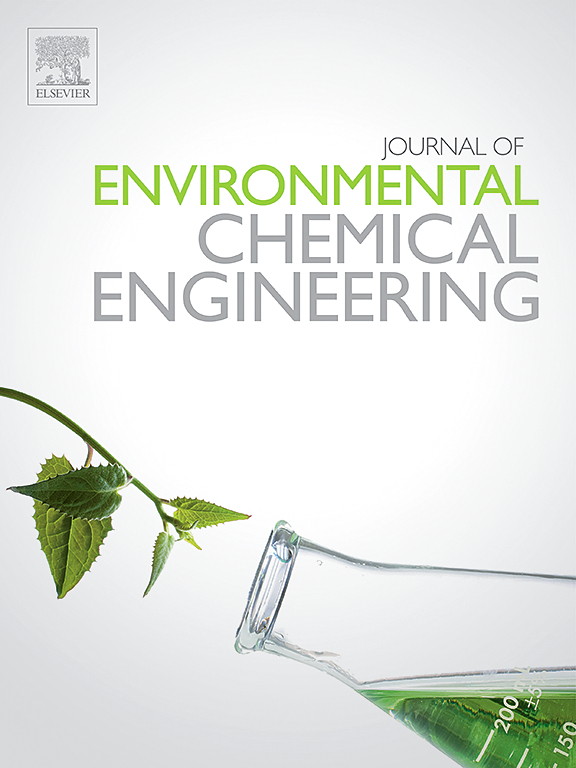Specialized nanotubular MnOx-CeO2/TiO2 composite catalysts for simultaneous low-temperature elimination of nitric oxide and ortho-dichlorobenzene
IF 7.4
2区 工程技术
Q1 ENGINEERING, CHEMICAL
引用次数: 0
Abstract
Novel TiO2-supported MnOx-CeO2 nanotubular catalysts (denoted as MnCe/Ti-NTs) were engineered for the simultaneous catalytic oxidation of ortho-dichlorobenzene (o-DCBz, CBCO) and selective catalytic reduction of NO with ammonia (NH3-SCR). The catalyst with optimized Mn/Ti (0.30) and Ce/Ti (0.10) molar ratios exhibits superior catalytic performance for both the CBCO and NH3-SCR reactions, achieving >90 % conversion efficiencies for both pollutants within the range of 275–360 °C. This outstanding performance originates from the well-balanced surface acidity and redox properties of the Mn0.30Ce0.10/Ti-NTs catalyst. Notably, this catalyst exhibits remarkable reaction selectivity and strong resistance to CBCO interference, with NH3-SCR preferentially proceeding. Moreover, CBCO modulates the redox properties of the catalyst and suppresses the non-selective oxidation of NH3 above 300 °C, which enhances the high-temperature deNOx reaction. Although competitive adsorption between NH3-SCR and CBCO for surface reactive oxygen species raises the T90 % for o-DCBz conversion from 225 °C to 275 °C and slightly reduces the CO2 selectivity, the H protons generated from NH3 activation promote the dichlorination of o-DCBz and then remove the Cl atom in the form of HCl. To optimize the simultaneous low-temperature catalytic removal of o-DCBz and NO, further enriching the MnCe/Ti-NTs catalyst with surface reactive oxygen species is crucial. These findings provide both theoretical insights and practical guidance for designing dual-functional catalysts for the simultaneous catalytic removal of chlorinated volatile organic compounds (CVOCs) and NOx at low temperatures.
纳米管MnOx-CeO2/TiO2复合催化剂用于同时低温去除一氧化氮和邻二氯苯
设计了新型二氧化钛负载MnOx-CeO2纳米管催化剂(MnCe/Ti-NTs),用于同时催化氧化邻二氯苯(o-DCBz, CBCO)和氨(NH3-SCR)选择性催化还原NO。优化后的Mn/Ti(0.30)和Ce/Ti(0.10)摩尔比的催化剂在CBCO和NH3-SCR反应中表现出优异的催化性能,在275-360 °C范围内对两种污染物的转化效率均达到>;90 %。这种优异的性能源于Mn0.30Ce0.10/Ti-NTs催化剂的良好平衡的表面酸度和氧化还原性能。值得注意的是,该催化剂具有显著的反应选择性和对CBCO干扰的强抗性,NH3-SCR优先反应。此外,CBCO调节了催化剂的氧化还原性能,抑制了300℃以上NH3的非选择性氧化,增强了高温脱硝反应。虽然NH3- scr和CBCO对表面活性氧的竞争吸附使o-DCBz在225℃至275℃的转化率提高了t90%,并略微降低了CO2的选择性,但NH3活化产生的H质子促进了o-DCBz的二氯化,然后以HCl的形式去除Cl原子。为了优化同时低温去除o-DCBz和NO的效果,进一步用表面活性氧富集MnCe/Ti-NTs催化剂至关重要。这些发现为设计低温同时催化去除氯化挥发性有机化合物(CVOCs)和NOx的双功能催化剂提供了理论见解和实践指导。
本文章由计算机程序翻译,如有差异,请以英文原文为准。
求助全文
约1分钟内获得全文
求助全文
来源期刊

Journal of Environmental Chemical Engineering
Environmental Science-Pollution
CiteScore
11.40
自引率
6.50%
发文量
2017
审稿时长
27 days
期刊介绍:
The Journal of Environmental Chemical Engineering (JECE) serves as a platform for the dissemination of original and innovative research focusing on the advancement of environmentally-friendly, sustainable technologies. JECE emphasizes the transition towards a carbon-neutral circular economy and a self-sufficient bio-based economy. Topics covered include soil, water, wastewater, and air decontamination; pollution monitoring, prevention, and control; advanced analytics, sensors, impact and risk assessment methodologies in environmental chemical engineering; resource recovery (water, nutrients, materials, energy); industrial ecology; valorization of waste streams; waste management (including e-waste); climate-water-energy-food nexus; novel materials for environmental, chemical, and energy applications; sustainability and environmental safety; water digitalization, water data science, and machine learning; process integration and intensification; recent developments in green chemistry for synthesis, catalysis, and energy; and original research on contaminants of emerging concern, persistent chemicals, and priority substances, including microplastics, nanoplastics, nanomaterials, micropollutants, antimicrobial resistance genes, and emerging pathogens (viruses, bacteria, parasites) of environmental significance.
 求助内容:
求助内容: 应助结果提醒方式:
应助结果提醒方式:


